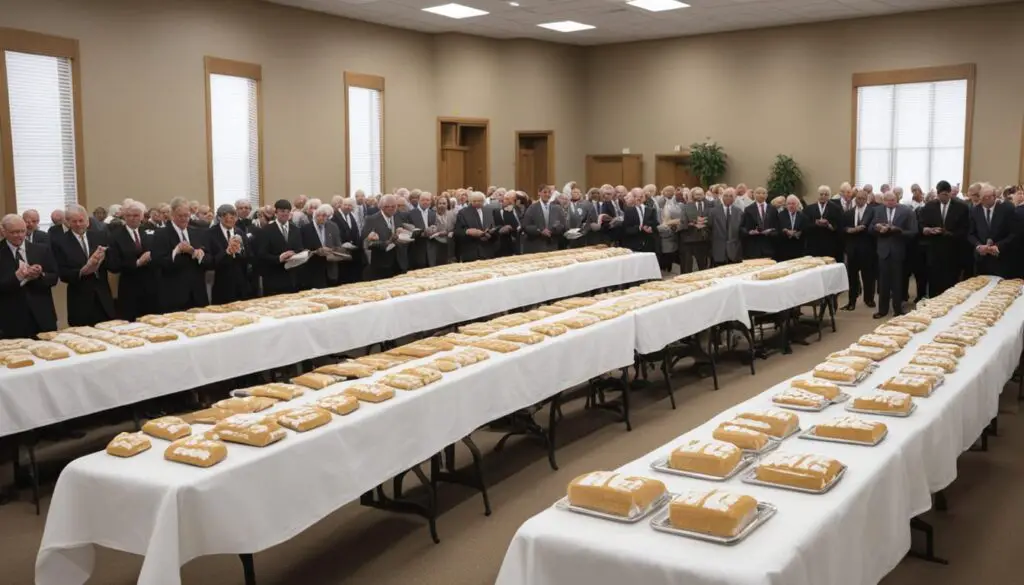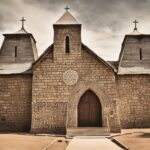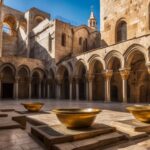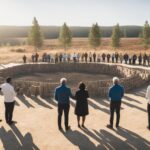The Church of Jesus Christ of Latter-day Saints, also known as the LDS Church or the Mormon Church, was founded in 1830 by Joseph Smith. Smith claimed to have received visions and revelations from God, including the Book of Mormon, which he translated from golden plates. The church was initially known as the Church of Christ, but later changed its name to the Church of Jesus Christ of Latter-day Saints. Its headquarters are located in Salt Lake City, Utah.
Key Takeaways:
- The Latter Day Saints Church was founded in 1830 by Joseph Smith
- Smith claimed to have received visions and revelations from God, including the Book of Mormon
- The church was initially known as the Church of Christ and later changed its name to the Church of Jesus Christ of Latter-day Saints
- The headquarters of the LDS Church are in Salt Lake City, Utah
- The church has a rich history and has become a significant religious denomination with a global presence
Beliefs and Doctrines of the Latter Day Saints Church
The Latter Day Saints Church, also known as Mormonism, has a unique and distinctive set of beliefs and doctrines that form the foundation of its faith. These beliefs are derived from a combination of sacred texts, including the Bible, the Book of Mormon, the Doctrine and Covenants, and the Pearl of Great Price.
Central to the beliefs of the Latter Day Saints Church is the concept of ongoing revelation and the continuous restoration of God’s truth. They believe that God speaks to prophets in the present day and that these prophets receive divine guidance for the church and its members.
One of the core beliefs of the church is the divinity of Jesus Christ and his atonement for the sins of humanity. They believe that through faith in Jesus Christ and following his teachings, individuals can be redeemed and experience eternal life.
The Latter Day Saints Church also places a strong emphasis on the importance of family. They believe in the concept of eternal families, where relationships can extend beyond mortality and continue into the eternities. They see families as central to God’s plan for his children and strive to strengthen and preserve family bonds.
Another unique belief of the Latter Day Saints Church is the concept of human potential and the possibility for individuals to become gods in the afterlife. They believe that through righteous living and following the teachings of the church, individuals can progress spiritually and eventually attain godhood.
These beliefs and doctrines shape the daily lives and practices of members of the Latter Day Saints Church, guiding their moral decisions, relationships, and service to others.
“Our doctrine is a revelation-based faith. We firmly believe that God continues to speak to humankind, and we eagerly anticipate the additional revelations that will yet come, including those contained in the Bible’s final book.” – Elder Quentin L. Cook
Mormonism Key Beliefs and Doctrines:
- Belief in ongoing revelation and the restoration of God’s truth
- Belief in the divinity of Jesus Christ and his atonement
- Belief in eternal families and the importance of family
- Belief in the potential for humans to become gods in the afterlife

The core beliefs and doctrines of the Latter Day Saints Church shape the lives of its members and provide a framework for their relationship with God, fellow believers, and their communities.
Sacraments and Rituals of the Latter Day Saints Church
The Latter Day Saints Church holds sacraments and rituals in high regard, considering them essential for spiritual growth and progression. These ceremonies play a significant role in the church’s beliefs about salvation and eternal life.
Baptism
Baptism is a fundamental sacrament in the Latter Day Saints Church. It symbolizes the remission of sins and the individual’s commitment to follow Jesus Christ. This ordinance is typically performed by immersion in water.
Confirmation
Confirmation is the sacrament that follows baptism. It involves the laying on of hands by authorized priesthood holders to bestow the gift of the Holy Ghost upon the individual. Through confirmation, believers receive the Holy Spirit as a guide and comforter.
The Sacrament
The sacrament in the Latter Day Saints Church is similar to the communion practiced in other Christian denominations. It involves partaking of bread and water, which represent the body and blood of Jesus Christ. This ordinance is a weekly ritual performed during Sunday worship services.
Priesthood Ordination
Priesthood ordination is a sacred ritual where worthy male members receive the authority to act in God’s name. The priesthood in the Latter Day Saints Church is divided into two levels: the Aaronic Priesthood and the Melchizedek Priesthood. Ordination is seen as a responsibility and a privilege to serve others.
Endowment
The endowment is a ritual that occurs within the temple and involves instruction, covenants, and anointing with sacred oil. It is a deeply symbolic ceremony where participants receive knowledge, blessings, and commitments related to their eternal journey and relationship with God.
Celestial Marriage
Celestial marriage, also known as eternal marriage, is a paramount ordinance in the Latter Day Saints Church. It signifies a covenant between a man and a woman that extends beyond mortal existence and is sealed for eternity. It is believed to be the highest form of marriage in the eyes of God.
Comparison of Sacraments and Rituals in the Latter Day Saints Church
| Sacrament/Ritual | Significance | Performance |
|---|---|---|
| Baptism | Symbolizes remission of sins and commitment to Christ | By immersion in water |
| Confirmation | Bestows the gift of the Holy Ghost | Laying on of hands by authorized priesthood holders |
| The Sacrament | Renewal of covenants and remembrance of Christ’s sacrifice | Partaking of bread and water during Sunday services |
| Priesthood Ordination | Granting of priesthood authority | Laying on of hands by authorized priesthood holders |
| Endowment | Receiving knowledge, blessings, and commitments related to the eternal journey | Performed within the temple |
| Celestial Marriage | Sealing of a man and a woman for eternity | Performed within the temple |

Leadership and Clergy in the Latter Day Saints Church
The Latter Day Saints Church operates under a hierarchical leadership structure, which plays a pivotal role in guiding and directing the church’s activities. The leadership positions are filled by individuals who are believed to be chosen by divine appointment and who receive guidance through revelation.
Prophet and President of the Church
The highest authority in the Latter Day Saints Church is the President, who is considered a prophet, seer, and revelator. The President is believed to be the earthly representative of Jesus Christ and receives divine revelation and guidance for the church. The current President is Russell M. Nelson, who holds the position of prophet and President of the Church.
Apostles
Below the President are the apostles, who are twelve in number and serve as special witnesses of Jesus Christ. They hold the highest level of priesthood authority and are responsible for leading the worldwide Church. The apostles are deeply involved in guiding the Church’s policies, teachings, and global outreach. Some notable apostles include Dallin H. Oaks and Henry B. Eyring.
Bishops
Bishops are local leaders who oversee the spiritual and temporal welfare of their congregations, called wards. They are chosen from the laity and serve in a volunteer capacity. Bishops provide guidance, support, and counseling to the members of their ward, and also manage the Church’s welfare resources at a local level.
Priesthood
The Latter Day Saints Church places a strong emphasis on the priesthood, which is considered the power and authority to act in God’s name. The priesthood is available to worthy male members who meet certain standards. It is organized into two levels: the Aaronic Priesthood and the Melchizedek Priesthood. Through the priesthood, individuals can officiate in sacred ordinances, teach and lead others, and serve in various capacities within the Church.
Leadership Structure:
| Position | Responsibilities | Notable Figures |
|---|---|---|
| President | Receives divine revelation and guidance for the Church; leads the worldwide Church | Russell M. Nelson |
| Apostles | Serve as special witnesses of Jesus Christ; lead the worldwide Church | Dallin H. Oaks, Henry B. Eyring |
| Bishops | Oversee the spiritual and temporal welfare of local congregations | Local leaders chosen from the laity |
| Priesthood | Power and authority to act in God’s name; perform sacred ordinances and serve in various capacities | Available to worthy male members |
Worship Practices of the Latter Day Saints Church
The worship practices of the Latter Day Saints Church are centered around Sunday services, known as sacrament meetings. These meetings serve as a time for members to gather and worship together.
Sacrament Meeting: At the heart of Sunday worship is the sacrament meeting, where members partake of the sacrament, or communion. This sacred ordinance is a symbolic remembrance of Jesus Christ’s sacrifice and serves as a time for reflection, renewal, and rededication to living the principles of the gospel. Hymn singing, prayers, and sermons are also an integral part of the sacrament meeting.
Sunday School: In addition to sacrament meetings, the Latter Day Saints Church holds Sunday School classes. These classes provide an opportunity for members to deepen their understanding of the scriptures, learn more about the teachings of the Church, and discuss how to apply these principles in their daily lives.
Relief Society: The Relief Society is the women’s organization within the Church. It holds separate meetings where women gather to learn, support, and strengthen one another. These meetings provide a nurturing and uplifting environment for women to develop their faith, serve others, and receive guidance and inspiration.
Primary: The Primary is the organization for children in the Church. It holds age-appropriate meetings that focus on teaching children about the gospel, instilling moral values, and fostering a love for God and others. The Primary provides a nurturing and safe environment where children can learn and grow spiritually.
Aside from these regular Sunday worship practices, members of the Latter Day Saints Church also engage in other forms of worship. These include temple attendance, where they participate in sacred ordinances and seek personal revelation. They also engage in personal and family prayer as a way to communicate with God and strengthen their relationship with Him. Additionally, members are encouraged to engage in daily scripture study, which involves reading and pondering the teachings found in the Bible, Book of Mormon, Doctrine and Covenants, and Pearl of Great Price.

The worship practices of the Latter Day Saints Church create a sense of unity, spiritual growth, and connection to God and fellow members. These practices contribute to the vibrant and devoted religious experience of Church members.
Sacred Texts of the Latter Day Saints Church
The Latter Day Saints Church considers four texts to be sacred: the Bible, the Book of Mormon, the Doctrine and Covenants, and the Pearl of Great Price. These texts are believed to contain revelations from God and provide guidance for church members. The church has an open canon, meaning that additional revelations can be added to the scriptures as needed.
Let’s explore the significance of these sacred texts:
The Bible
The Bible is considered sacred by the Latter Day Saints Church, just as it is by many other Christian denominations. It contains the Old and New Testaments and is believed to be the word of God as inspired by prophets and apostles.
The Book of Mormon
The Book of Mormon is a foundational text for the Latter Day Saints Church. According to the church’s teachings, Joseph Smith translated the Book of Mormon from ancient golden plates. It is considered an additional witness to the divinity of Jesus Christ and contains the religious history and teachings of ancient American civilizations.
The Doctrine and Covenants
The Doctrine and Covenants is a collection of revelations received by Joseph Smith and subsequent prophets in the early days of the church. It contains teachings, commandments, and instructions for the members of the church. The Doctrine and Covenants is seen as a modern-day addition to the biblical canon.
The Pearl of Great Price
The Pearl of Great Price is a compilation of writings that includes the Book of Moses, the Book of Abraham, Joseph Smith’s translation of Matthew, excerpts from Joseph Smith’s history, and a selection of hymns. It provides additional insights into the church’s beliefs and practices.

The Latter Day Saints Church believes that these sacred texts, together with the Bible, serve as a guide for their members’ faith and conduct. The teachings found within these texts are seen as authoritative and provide the foundation for the church’s doctrines and principles.
“The sacred texts of the Latter Day Saints Church offer spiritual guidance, insights into God’s plan, and instructions for righteous living. They serve as a source of inspiration, personal revelation, and a continual connection to God.”
The open canon of the Latter Day Saints Church allows for ongoing revelation and the possibility of additional scripture being added to the sacred texts in the future. This concept of an open canon reflects the belief that God continues to communicate with his children and provide guidance specific to their time and circumstances.
| Sacred Text | Purpose |
|---|---|
| The Bible | Contains the word of God and the teachings of ancient prophets |
| The Book of Mormon | Provides a witness to the divinity of Jesus Christ and the history of ancient American civilizations |
| The Doctrine and Covenants | Offers modern-day revelations and commandments for the church |
| The Pearl of Great Price | Includes additional writings and insights into the church’s beliefs and practices |
Denominations and Sects within the Latter Day Saints Movement
The Latter Day Saints Movement encompasses various denominations and sects that trace their roots back to the teachings of Joseph Smith. While they share a common heritage, these groups have different beliefs and practices that have shaped their distinct identities within the movement.
Community of Christ
The Community of Christ, headquartered in Independence, Missouri, is the largest denomination within the Latter Day Saints Movement. Formerly known as the Reorganized Church of Jesus Christ of Latter Day Saints, the Community of Christ emphasizes peace, justice, and community. They believe in continued revelation and open scripture, allowing for theological evolution.
Church of Jesus Christ
The Church of Jesus Christ, based in Monongahela, Pennsylvania, is a smaller denomination that also aligns itself with the legacy of Joseph Smith. They emphasize the importance of personal revelation and spiritual experiences, and they adhere closely to the teachings found in the Book of Mormon and other Latter Day Saints scriptures.
Fundamentalist Church of Jesus Christ of Latter-Day Saints
The Fundamentalist Church of Jesus Christ of Latter-Day Saints (FLDS) is a sect within the Latter Day Saints Movement that diverged from the mainstream LDS Church in the early 20th century. The FLDS still practices polygamy and adheres to earlier teachings and practices of the movement. The sect is centered around its own prophet and isolated communities primarily located in Utah and Arizona.
The various denominations and sects within the Latter Day Saints Movement reflect the diverse interpretations and adaptations of Joseph Smith’s teachings. While they may differ in their beliefs and practices, all of these groups share a common heritage and influence from the restorationist movement founded by Smith in the 19th century.
Community and Outreach in the Latter Day Saints Church
The Latter Day Saints Church recognizes the importance of community and outreach as fundamental principles of their faith. At the heart of their message is the belief in loving and serving their fellow human beings, both within the church and in the wider world.
One of the most well-known ways the church engages in outreach is through its extensive missionary program. The church organizes missions around the world, where dedicated individuals, typically young adults, are called to serve as full-time missionaries. These missionaries aim to spread the teachings of the Latter Day Saints Church and promote its values of love, compassion, and faith. They devote their time and efforts to building relationships, teaching others about the church’s beliefs, and assisting those in need.
The missionary program goes beyond simply sharing their faith. The Latter Day Saints Church is committed to humanitarian services, responding to crises and supporting vulnerable communities globally. Through their network of humanitarian organizations, they provide aid, including food, clean water, medical assistance, and educational resources to those affected by natural disasters, poverty, and conflict.

In addition to their emphasis on missionary work, the Latter Day Saints Church places a strong focus on family history and genealogy research. Through the Family History program, church members are encouraged to trace their ancestry, preserve family records, and perform sacred ordinances on behalf of their deceased ancestors. This practice strengthens family connections and fosters a sense of unity and continuity within the community.
The church’s commitment to welfare is yet another aspect of their community and outreach endeavors. With a comprehensive welfare program, the church establishes local bishops’ storehouses and welfare farms to provide food and resources for those in need. This program allows members to actively contribute to the well-being of their fellow church members and the wider community, ensuring that no one is left behind.
The Latter Day Saints Church firmly believes that meeting the spiritual, emotional, and physical needs of individuals and families fosters a stronger sense of community. They encourage their members to reach out and support one another, creating an environment of love, compassion, and understanding.
Community and outreach are not merely buzzwords for the Latter Day Saints Church – they are deeply ingrained principles that guide their actions and shape their commitment to making a positive impact both locally and globally.
Architectural and Artistic Features in the Latter Day Saints Church
The Latter Day Saints Church is known for its distinctive architectural and artistic features. The design of their buildings reflects the sacredness and significance of their religious practices.
Temples
Temples hold a central place in the worship of the Latter Day Saints Church. These majestic structures are dedicated to sacred ordinances and rituals. Each temple is meticulously designed, featuring intricate stonework, beautiful stained glass windows, and ornate interiors. Temples symbolize the connection between heaven and earth for the Latter Day Saints, and they serve as a place of worship, contemplation, and spiritual renewal.
Meetinghouses and Tabernacles
In addition to temples, the Latter Day Saints Church also has meetinghouses and tabernacles that cater to the needs of their congregations. Meetinghouses are designed to be functional, providing spaces for worship services, Sunday School classes, and other church activities. Tabernacles, on the other hand, are larger and typically used for conferences and special events. These buildings often showcase a blend of contemporary and traditional architectural elements.
Choruses and Choirs
Music holds a special place in the worship of the Latter Day Saints Church. Choruses and choirs are an integral part of their religious gatherings, adding a rich and uplifting element to their worship practices. The harmonious voices and inspiring melodies create a sense of unity and reverence, enhancing the spiritual experience of worshipers.
Through their architectural and artistic features, the Latter Day Saints Church creates spaces that inspire awe and reverence, fostering a deep connection to their religious beliefs and practices.
Contemporary Issues and Challenges in the Latter Day Saints Church
The Latter Day Saints Church, like any religious institution, faces its fair share of contemporary issues and challenges. From disputes over historical claims to criticisms of its treatment of minorities, the church is continually navigating a complex landscape. Financial transparency and the ongoing impact of its history of polygamy are further challenges that the church tackles with resilience and adaptability.
One of the key challenges faced by the Latter Day Saints Church relates to historical claims. Some individuals and groups question the validity and accuracy of the church’s history and origins, leading to ongoing debates and disagreements. The church strives to address these concerns with transparency, providing historical context and seeking to forge a deeper understanding among its members and the wider community.
Another important issue is the treatment of minorities within the church. The Latter Day Saints Church has faced criticism for its historical stance on racial and gender equality. It has since made efforts to address these concerns and promote inclusivity and diversity within its ranks. The church recognizes the importance of equality and strives to create an environment where every individual feels valued and respected.
Financial transparency is also a significant contemporary challenge for the Latter Day Saints Church. Critics have raised questions about the church’s finances, including its use of donations and its level of financial accountability. The church is committed to addressing these concerns by promoting openness and providing clearer insights into its financial operations and stewardship.
Furthermore, the church is acutely aware of the ongoing impact of its historical practice of polygamy. Although the church officially discontinued polygamy in 1890, it remains a topic of public interest and scrutiny. The church seeks to provide education and context regarding its historical practices while emphasizing its commitment to monogamy in the present day.
Despite these challenges, the Latter Day Saints Church continues to adapt and navigate the evolving societal landscape. It is committed to addressing contemporary issues, fostering inclusivity, and maintaining transparency. By actively engaging with these challenges, the church seeks to honor its heritage while building a stronger and more resilient community of believers.
Global Presence and Influence of the Latter Day Saints Church
The Latter Day Saints Church has a truly global presence, with congregations and temples established in numerous countries around the world. This widespread reach reflects the church’s commitment to spreading its beliefs and engaging with diverse communities.
One of the key ways the church extends its global influence is through its missionary work. Dedicated members of the church, known as missionaries, actively share their faith and teachings with individuals and communities across the globe. Through their efforts, the church has been able to reach people from all walks of life and introduce them to the principles and doctrines of the Latter Day Saints Church.
Moreover, the church operates various institutions that contribute to its global influence. These institutions include philanthropies that provide humanitarian aid and support to those in need, both locally and internationally. Additionally, the church has established tertiary education institutions that offer academic programs rooted in their religious beliefs and values.
The impact of the Latter Day Saints Church extends beyond its faithful members. The church’s principles and teachings have had a significant influence on the lives of its followers, shaping their values, relationships, and daily practices. Moreover, the church has actively engaged in charitable endeavors, fulfilling its mission to serve and uplift individuals and communities worldwide.
“As members of the Latter Day Saints Church, we strive to make a positive difference in the world and truly live our faith. Through service, outreach, and the spread of our beliefs, we aim to inspire goodness, kindness, and compassion, leaving a lasting impact wherever we go.”
Membership and Growth
The Latter Day Saints Church boasts a substantial and ever-growing membership, both in the United States and internationally. The church’s commitment to missionary work and outreach efforts has played a significant role in its steady growth. As new individuals embrace the teachings and principles of the church, its global presence and influence continue to expand.
Institutions
The Latter Day Saints Church operates various institutions that support its global presence and influence. These institutions serve as centers for education, religious worship, and community engagement. They provide resources and services that cater to the needs of church members and the broader communities they serve.
| Institution | Purpose |
|---|---|
| Temples | Sacred spaces for performing specific ordinances and rituals |
| Meetinghouses | Places of worship and congregational gatherings |
| Tabernacles | Venues for gatherings, concerts, and other cultural events |
| Choruses and Choirs | Music programs that enhance worship and inspire spiritual connection |
These institutions not only provide spaces for spiritual growth and worship but also contribute to the overall influence and engagement of the Latter Day Saints Church on a global scale.
“Through our global presence and influence, we seek to bring light, hope, and the teachings of Jesus Christ to every corner of the world. We are dedicated to building bridges of understanding, fostering unity, and making a positive impact on the lives of individuals and communities.”
Conclusion
The Latter Day Saints Church, also known as the LDS Church or the Mormon Church, has a rich history and a unique set of beliefs and practices. Founded by Joseph Smith in 1830, the church has grown to become a significant religious denomination with a global presence. From its beginnings, it has faced various challenges and controversies, but it has continued to thrive and impact the lives of its members.
The LDS Church’s beliefs and doctrines are centered around the teachings of Jesus Christ as revealed through sacred texts such as the Bible, the Book of Mormon, the Doctrine and Covenants, and the Pearl of Great Price. The church places a strong emphasis on personal revelation, eternal families, and the potential for individuals to become gods in the afterlife.
Through its sacraments and rituals, such as baptism, confirmation, sacrament meetings, and temple ordinances, the church provides members with opportunities for spiritual growth and progression. These practices are seen as essential for salvation and eternal life.
With a strong emphasis on community and outreach, the LDS Church engages in various humanitarian efforts, missionary work, and programs focused on family history research and welfare. Its architectural and artistic features, such as temples and choirs, are known for their beauty and significance. As the church faces contemporary challenges and adapts to changing societal norms, it continues to have a profound influence on the lives of its members and the communities in which they reside.
FAQ
What is the history and origin of the Latter Day Saints Church?
The Church of Jesus Christ of Latter-day Saints, also known as the LDS Church or Mormon Church, was founded in 1830 by Joseph Smith. Smith claimed to have received visions and revelations from God, including the Book of Mormon, which he translated from golden plates. The church was initially known as the Church of Christ, but later changed its name to the Church of Jesus Christ of Latter-day Saints.
What are the beliefs and doctrines of the Latter Day Saints Church?
The Latter Day Saints Church believes in the Bible as well as three other sacred texts: the Book of Mormon, the Doctrine and Covenants, and the Pearl of Great Price. The church emphasizes the importance of personal revelation and the continuous restoration of God’s truth. They believe in the divinity of Jesus Christ and his atonement for humanity’s sins. They also believe in the concept of eternal families and the potential for humans to become gods in the afterlife.
What are the sacraments and rituals of the Latter Day Saints Church?
The Latter Day Saints Church has several sacraments and rituals that are considered essential for members’ spiritual growth and progression. These include baptism, confirmation, the sacrament (similar to communion), priesthood ordination, endowment, and celestial marriage. These rituals play a significant role in the church’s beliefs about salvation and eternal life.
What is the leadership and clergy structure in the Latter Day Saints Church?
The Latter Day Saints Church has a hierarchical leadership structure. The highest authority is the President of the Church, who is considered a prophet, seer, and revelator. The president is believed to receive divine revelation and guidance for the church. Below the president are the apostles, who hold the highest level of priesthood authority. Bishops, drawn from the laity, lead local congregations called wards. The church places a strong emphasis on the priesthood, which is available to male members who meet certain standards.
What are the worship practices of the Latter Day Saints Church?
The Latter Day Saints Church has regular Sunday worship services, known as sacrament meetings. These meetings include hymn singing, prayers, and sermons. They also have Sunday School classes, where members study the scriptures, and separate meetings for women (Relief Society) and children (Primary). They also participate in various other forms of worship, such as temple attendance, personal and family prayer, and scripture study.
What are the sacred texts of the Latter Day Saints Church?
The Latter Day Saints Church considers four texts to be sacred: the Bible, the Book of Mormon, the Doctrine and Covenants, and the Pearl of Great Price. These texts are believed to contain revelations from God and provide guidance for church members. The church has an open canon, meaning that additional revelations can be added to the scriptures as needed.
What are the denominations and sects within the Latter Day Saints Movement?
The Latter Day Saints Movement encompasses various denominations and sects that trace their roots back to the teachings of Joseph Smith. The largest denomination is the Community of Christ, which is headquartered in Independence, Missouri. Other groups include the Church of Jesus Christ, based in Monongahela, Pennsylvania, and the Fundamentalist Church of Jesus Christ of Latter-Day Saints (FLDS). These groups share a common heritage but have different beliefs and practices.
What is the community and outreach like in the Latter Day Saints Church?
The Latter Day Saints Church places a strong emphasis on community and outreach. They have a robust missionary program that aims to spread their beliefs and provide humanitarian services worldwide. The church also has programs focused on family history research and welfare, providing aid to those in need. Community and fellowship are important aspects of the church’s teachings.
What are the architectural and artistic features in the Latter Day Saints Church?
The Latter Day Saints Church is known for its distinctive architectural and artistic features. They build temples, which are considered sacred spaces for performing specific ordinances and rituals. These temples often have unique and intricate designs. The church also has many meetinghouses, tabernacles, and other buildings that serve as places of worship. The church has a rich tradition of music and is known for its choruses and choirs.
What are the contemporary issues and challenges in the Latter Day Saints Church?
The Latter Day Saints Church faces various contemporary issues and challenges. These include disputes over the church’s historical claims, criticisms of its treatment of minorities, financial transparency, and the ongoing impact of its history of polygamy. The church has worked to address these issues and adapt to changing societal norms.
What is the global presence and influence of the Latter Day Saints Church?
The Latter Day Saints Church has a global presence and is known for its missionary work around the world. They have established congregations and built temples in numerous countries. The church operates various institutions, including philanthropies and tertiary education institutions. The church’s beliefs and practices have had a significant influence on the lives of its members and the communities where they reside.
















